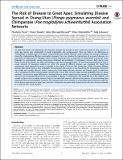The risk of disease to great apes : Simulating disease spread in orang-utan (pongo pygmaeus wurmbii) and chimpanzee (pan troglodytes schweinfurthii) association networks
Abstract
All great ape species are endangered, and infectious diseases are thought to pose a particular threat to their survival. As great ape species vary substantially in social organisation and gregariousness, there are likely to be differences in susceptibility to disease types and spread. Understanding the relation between social variables and disease is therefore crucial for implementing effective conservation measures. Here, we simulate the transmission of a range of diseases in a population of orang-utans in Sabangau Forest (Central Kalimantan) and a community of chimpanzees in Budongo Forest (Uganda), by systematically varying transmission likelihood and probability of subsequent recovery. Both species have fission-fusion social systems, but differ considerably in their level of gregariousness. We used long-term behavioural data to create networks of association patterns on which the spread of different diseases was simulated. We found that chimpanzees were generally far more susceptible to the spread of diseases than orang-utans. When simulating different diseases that varied widely in their probability of transmission and recovery, it was found that the chimpanzee community was widely and strongly affected, while in orang-utans even highly infectious diseases had limited spread. Furthermore, when comparing the observed association network with a mean-field network (equal contact probability between group members), we found no major difference in simulated disease spread, suggesting that patterns of social bonding in orang-utans are not an important determinant of susceptibility to disease. In chimpanzees, the predicted size of the epidemic was smaller on the actual association network than on the mean-field network, indicating that patterns of social bonding have important effects on susceptibility to disease. We conclude that social networks are a potentially powerful tool to model the risk of disease transmission in great apes, and that chimpanzees are particularly threatened by infectious disease outbreaks as a result of their social structure.
Citation
Carne , C , Semple , S , Morrogh-Bernard , H , Zuberbühler , K & Lehmann , J 2014 , ' The risk of disease to great apes : Simulating disease spread in orang-utan (pongo pygmaeus wurmbii) and chimpanzee (pan troglodytes schweinfurthii) association networks ' , PLoS One , vol. 9 , no. 4 , e95039 . https://doi.org/10.1371/journal.pone.0095039
Publication
PLoS One
Status
Peer reviewed
ISSN
1932-6203Type
Journal article
Collections
Items in the St Andrews Research Repository are protected by copyright, with all rights reserved, unless otherwise indicated.

